Richard Feynman’s First Lecture (1940)
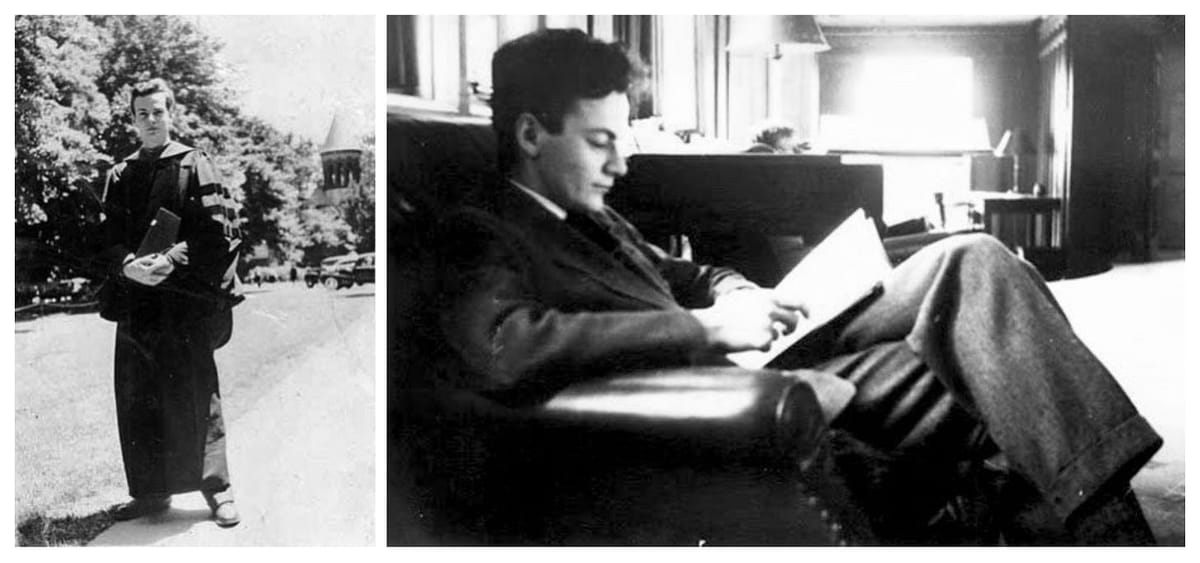
“I went through fire on my first.”
While still a graduate student at Princeton University in 1940, Richard P. Feynman (1918–1988) gave his first lecture in a seminar on electrodynamics, the topic that would eventually earn him the 1965 Nobel Prize in physics. In front of a prestigious audience consisting of Nobel laureates Albert Einstein (1879–1955), Wolfgang Pauli (1900–1958), and Eugene Wigner (1902–1995) as well as the Hungarian polymath John von Neumann (1903–1957), Feynman lectured on the current state of what is now known as the Wheeler- Feynman absorber theory.
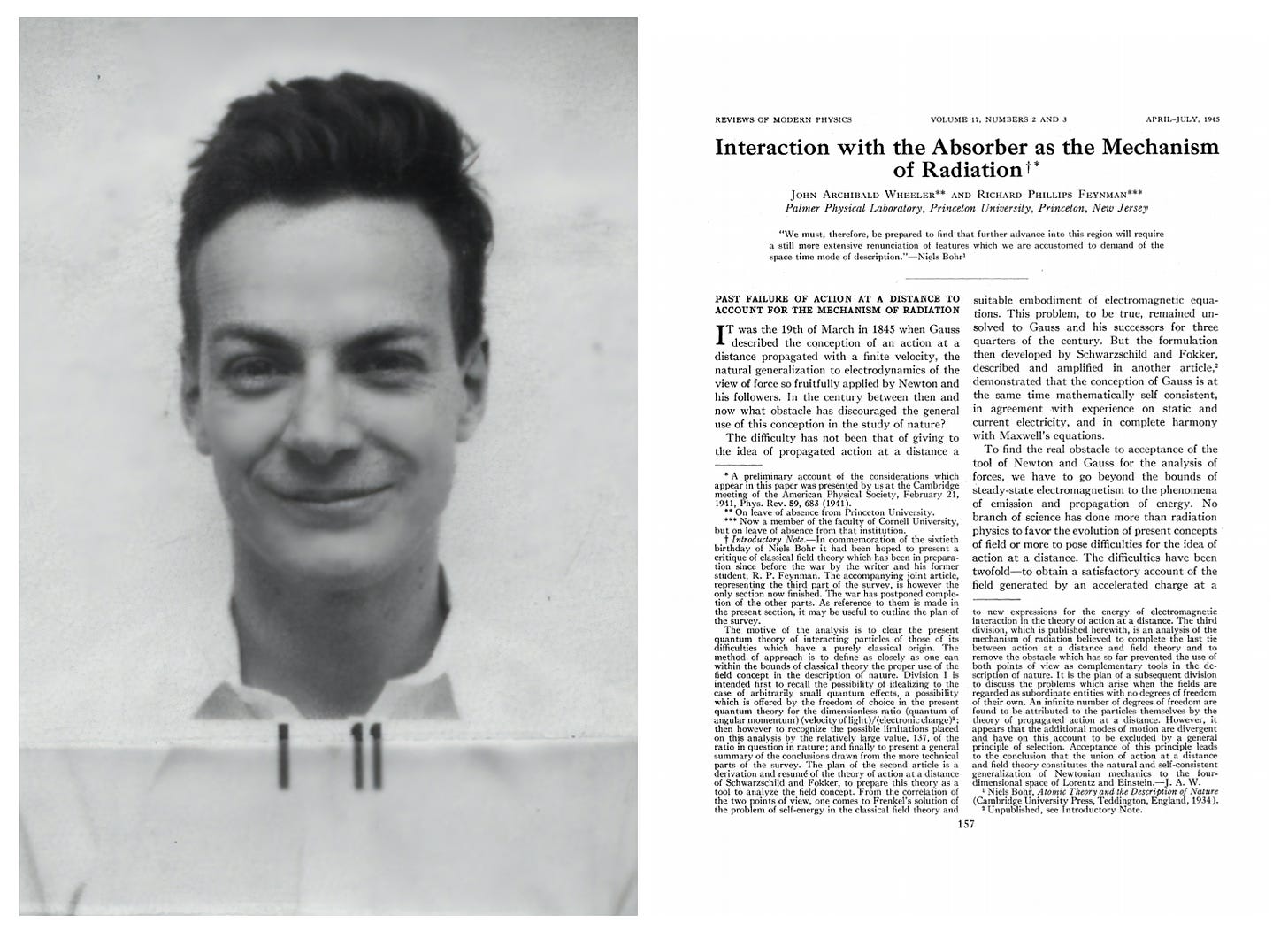
Feynman attended college at the Massachusetts Institute of Technology, graduating in 1939 with a B.Sc. Although he had originally studied mathematics, he eventually switched to electrical engineering because he considered mathematics to be “too abstract”. Noticing later that he had “gone too far” in the direction of the practical, he switched again, to physics. For his Ph.D, he applied and was accepted to Princeton University after achieving an unprecedented perfect score on the prestigious graduate school’s entrance exam in physics, as well as an outstanding score in mathematics. His Ph.D. thesis advisor Professor John A. Wheeler (1911–2008), who was only seven years older, described his enthusiasm of Feynman as follows:
“This chap from MIT: Look at his aptitude test ratings in mathematics and physics. Fantastic! Nobody else who’s applying here at Princeton comes anywhere near so close to the absolute peak.”
As an undergraduate, Feynman had already published two papers in the journal Physical Review before leaving for New Jersey:
- Vallerta, M.S. & Feynman, R.P. (1939). The Scattering of Cosmic Rays by the Stars of the Galaxy. Physical Review. American Physical Society 55(5). pp. 506–507.
- Feynman, R.P. (1939). Forces in Molecules. Physical Review. American Physical Society 56(4). pp. 340–343.
Princeton University
“The Mathematical Center of the Universe” — Harald Bohr, 1936
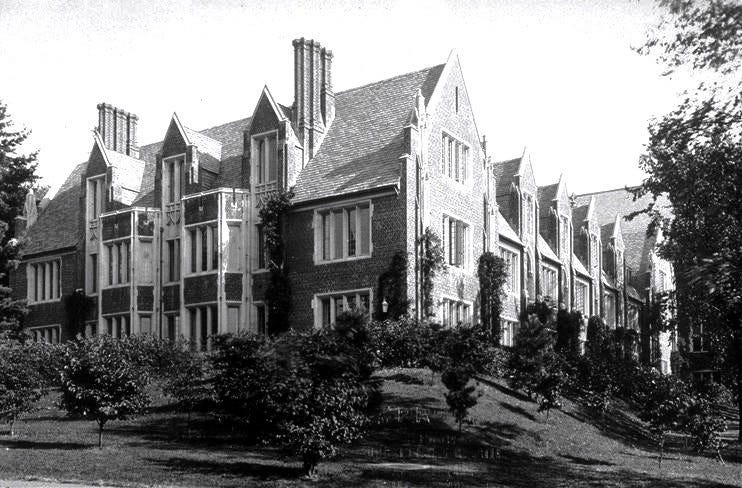
Feynman’s father drove him to the Graduate College at Princeton in the fall of 1939. Of his arrival, Mehra (1994) provides the following anecdote, which later inspired the title for Feynman’s best-selling 1985 biography Surely, You’re Joking Mr. Feynman*:
"Feynman had been barely an hour in his room in the Graduate College after arrival, trying to get settled, when the Master dropped by to see him and said: 'The Dean is having Tea and would like you and your roommate Mr. Serrette to come'.
[...]
Feynman was scared by the announcement: 'The Dean's Tea'. To him it sounded rather silly and high class [...] Together they went down to the Dean's tea on the very afternoon that Feynman arrived in Princeton.
[...]
As he went in, Feynman was thinking about where he should sit, because he wanted to do things right. [...] Feynman felt rather stiff. It was all very formal, [...] he heard a voice behind him say 'Would you like cream of lemon in your tea, Mr. Feynman?' This was Mrs Eisenhardt pouring tea.
Feynman absentmindedly answered, 'Both please, thank you'"
- Excerpt, The Beat of a Different Drum: The Life and Science of Richard Feynman* by Jagdish Mehra (1994)
The tradition of afternoon tea was very strong at Princeton in the 40s and 50s, as later described by Sylvia Nasar:
"There was only one requirement: come to tea. They were absolutely required to come to tea every afternoon. Where else would they meet the finest mathematics faculty in the world?"
- Excerpt, A Beautiful Mind* by Sylvia Nasar (1998)
The Wheeler-Feynman Absorber Theory
Ever since his time as an undergraduate at MIT, Feynman had wondered about “whether the electron does not act upon itself” (Mehra, 1994). That is, whether some of the difficulties of quantum electrodynamics (stemming from apparent infinities) in fact could be sorted out by assuming that electrons do not interact with themselves (resulting in infinite energy). As he later wrote:
"Two things were the source of the difficulties with the quantum electrodynamical theories. The first was that an infinite energy of interaction of the electron with itself. This difficulty existed even in the classical theory. The other difficulty came from the some infinities which had to do with the infinite numbers of degrees of freedom in the field.
[...]
Well, it seemed to me quite evident that the idea that a particle acts on itself, that the electrical force acts on the same particle that generates it, is not a necessary one -- it is sort of a silly one, as a matter of fact.
And so, I suggested to myself, that electrons cannot act on themselves, they can only act on other electrons. That means there is no field at all. You see, if all charges contribute to making a single common field, and if that common field acts back on al lthe charges, the each charge must act back on itself. Well, that was where the mistake was, there was no field."
- Excerpt, Selected Papers of Richard Feynman (with Commentary)* by Richard Feynman and Laurie M. Brown (2000)
Feynman’s assumption removed the problem of self-energies which had plagued many interpretations of electrodynamics.
"So, one day, when I was working for Professors Wheeler and could no longer solve the problem he had given me, I thought about this again and calculated the following.
Suppose I have two charges--I shake the first charge, which I think of as a source, and this makes the second one shake, but the second one shaking produces an effect back on the source. I calculated how much that effect back on the first charge was, hoping that it might add up to the force of radiation resistance. It didn't come out right, of course"
- Excerpt, The Beat of a Different Drum: The Life and Science of Richard Feynman* by Jagdish Mehra (1994)
In response to his work, Wheeler argued that
- The effect back on the source would depend on the charge and mass of the second charge, and would vary inversely as the square of the distance R between the charges, while the force of radiation resistance depended on neither;
- If there were many charges around the first source at roughly uniform density, one would get an infinite total effect back at the first source;
- When you “shake” the first charge, the second charge acts later, and the reaction back would act after that. The action in other words occurs at the wrong time;
This amounted to telling Feynman that he had calculated and described ordinary reflected light, not radiation reaction. Wheeler resolved Feynman’s problem a short while later by introducing advanced waves to get the reaction back at the right time and retarded waves to account for the waves coming back from the source. Feynman found the method “quite exciting, absolutely terrific”, and so Wheeler told him to “go home and find out how much advanced and how much retarded waves we need to get the right answer” (Mehra, 1994):
"That started it. [...] It became clear that there was the possibility that if we assume all actions via half-advanced and half-retarded solutions of Maxwell's equations and assume that the sources are surrounded by material absorbing all the light which is emitted, then we could account for radiation resistance as direct action of the charges of the absorber acting back by advanced waves on the source"
- Excerpt, The Beat of a Different Drum: The Life and Science of Richard Feynman* by Jagdish Mehra (1994)
Feynman spent several months checking their new theory, ensuring that it remained independent of the shape of the container and that the paradoxes that resulted from using advanced waves were addressed. As Feynman later recalled:
“My feeling was, even from the very beginning, that the first thing we had to solve, before we solved the quantum work with electrodynamics, was to straighten out the difficulties with the classical electrodynamics.”
The result was a classical theory of electrodynamics which had half-advanced and half-retarded waves, in which there was no self-energy problem as there were no electrons acting upon themselves. The next step was to turn their classical model into a quantum model. Before working it out, Wheeler suggested Feynman first present their classical theory to their colleagues at Princeton and the Institute for Advanced Study.
“Feynman, you’re a young fella — you should give a seminar on this” — John A. Wheeler
Feynman’s First Lecture (Fall, 1940)
“Everybody came in. I got up to give the lecture. I can still remember looking in front of me to see the envelope, and pulling out my notes, and the hand shaking — I can see it, the shaking hand because it was quite a thing.”
The Physics department at Princeton had a weekly seminar — later described by Feynman as a “Research Conference” where permanent, temporary and visiting faculty would give talks. Sometimes faculty from the Institute for Advanced Study would participate. The chairman of the colloquium was Professor Eugene Wigner. As the story goes, Wheeler told Feynman that he should “learn how to give talks”, promising “you […] give the talk and I shall answer the questions” (Mehra, 1994):
"Early in 1941 [Wheeler] told Feynman to prepare a presentation for the departmental seminar, usually a forum for distinguished visiting physicists, in February. It would be Feynman's first professional talk. He was nervous about it."
- Excerpt, Genius: The Life and Science of Richard Feynman* by James Gleick (1992)
In Feynman’s own words (Wiener, 1966):
"Wheeler decided we should give this stuff at the colloquium, it was worthwhile, and that I should do it, because it was a good lesson for me to learn how to talk, or something. I said, “Gee, you know, it scares me.” He said, “I promise to answer all the questions” — so that I wasn’t too petrified. It was my first experience at a real technical talk, see."
Leading up to the seminar, Feynman would challenge his friends in the graduate school such as William M. Woodward (1916–1983), John Tuckey (1915–2000) and others to try to explain the paradoxes of their theory back to him, leading to “Many discussions. Many arguments” (Wiener, 1966):
"You could explain the difficulties, and they would challenge you. I would say, “I think the difficulty is straightened out by supposing that for every — supposing that there’s no device which has a response" [..] Then they would argue, “Well, that’s not necessary, we could have mousetrap devices and so on” — you know.
It was like the old days with Bohr. I felt like that. You see, we knew the history of science, and that guys like Bohr would argue with — the uncertainty principle, or Heisenberg — they would argue about what would happen, how you would really not be able to measure something, in spite of the fact that someone would think you were, because if you built the apparatus… We had the same kind of reasoning."
A day or two before the talk, Feynman ran into Wigner who told him “I think your work with Wheeler is very interesting, so I’ve invited Russell to the seminar”:
"Professor Wigner was in charge of the colloquium, so after I said I would do it, he told me that he had heard from Wheeler about the work and he knew something about it. I think we had discussed it a little bit with him. And he thought it was important enough that he had taken the liberty to invite especially Professor Henry Norris Russell from the astronomy department, the great astronomer."
Henry Norris Russell (1877–1957) had together with Ejnar Hertzsprung (1873–1967) developed the Hertzsprung-Russell diagram in 1910. At the time Feynman’s seminar, Russell was 62 years old. Wigner tried to “brief” Feynman about him before the seminar started (Wiener, 1965):
"If Professor Russell falls asleep during your lecture it doesn’t mean it’s no good, it’s just because Professor Russell always falls asleep, but he’s listening; if Professor Pauli is nodding “yes” during the entire lecture, don’t be too impressed, because the man has palsy and nods “yes” all the time."
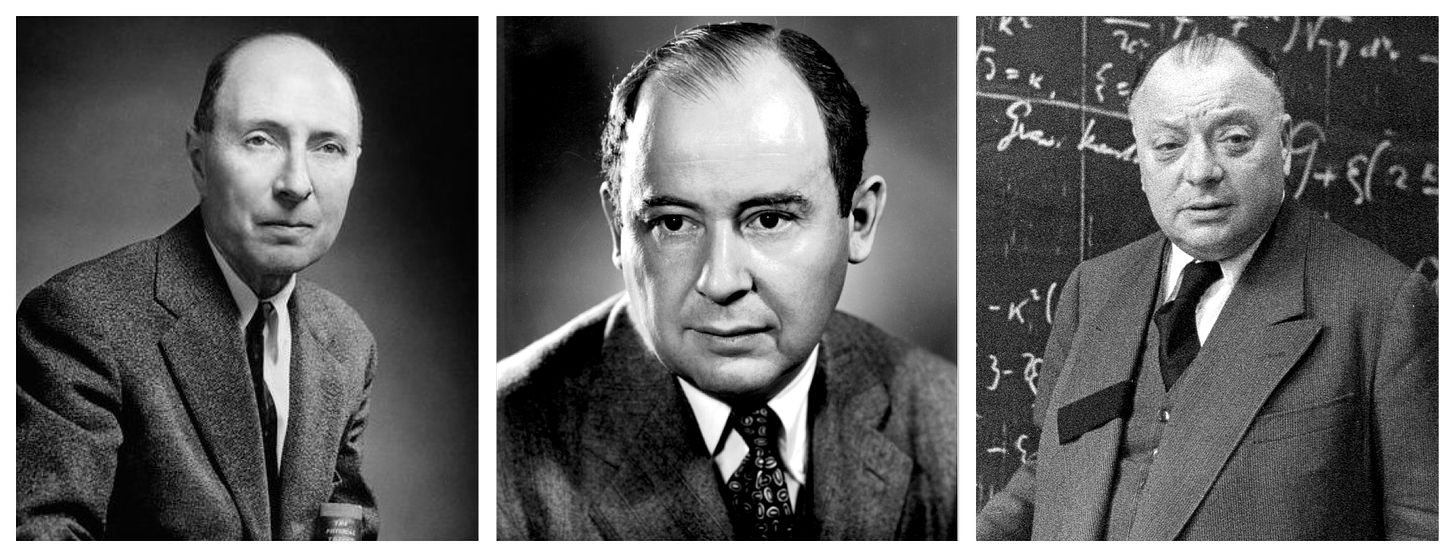
The latter referring to Wolfgang Pauli who would be awarded the Nobel Prize in Physics five years later in 1945, for his “decisive contribution through his discovery of a new law of Nature, the exclusion principle or Pauli principle”. He was visiting from ETH Zurich at the time of Feynman’s lecture. Also in attendance was, in Feynman’s words, “the world’s greatest mathematician” John von Neumann (Wiener, 1966).
"And Professor Einstein had been especially invited — and although he never comes to the colloquia, he thinks he will come!"
Feynman described his reaction to the list of invitees as follows to Charles Wiener (1966):
“I must have turned a yellowish-green or something, because I remember Professor Wigner assuring me not to worry, that they’re very nice men [...] He was trying to make me feel better, you see.”
Preceding the lecture, during tea, Feynman prepared by filling the blackboard behind him with equations describing the interaction between two charges:
"I came to the thing and gave the lecture. First of all, not having too much experience, I put equations all over the blackboard, all the equations on the blackboard, all over, filled. So I was busy for an hour and had a lecture filling the blackboard, and didn’t go to the tea previous to the lecture."
That is when Einstein showed up:
"Professor Einstein came by while I was filling the blackboard and said “hello” and asked me where the tea was, you see, and he went on to the tea — and I kept writing these equations."
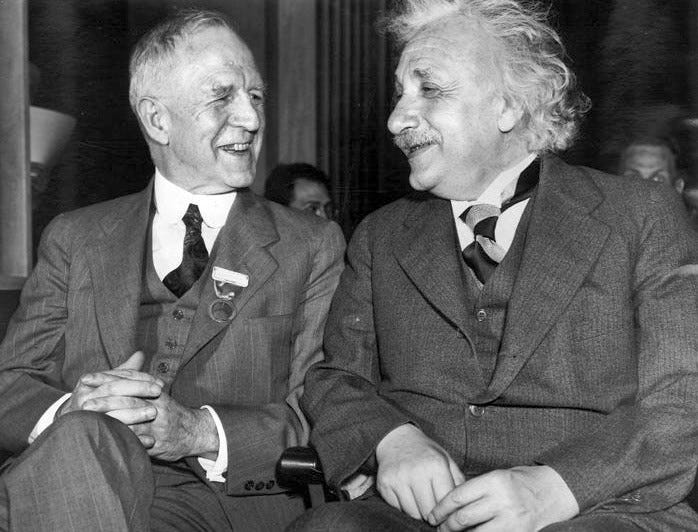
“I met him another time either before or after — I’m pretty sure before, now, because he knew me”, Feynman later recalled.
“Then, everybody came in and so on; I got up to give the lecture. I can still remember [looking] in front of me to see the envelope, and pulling out my notes, and the hand shaking--I can see it, the shaking hand because it was quite a thing.”
Pauli’s reaction to the lecture, as Feynman himself later recalled, was “I do not think this theory can be right because of this, that and the other thing”. Although he could not remember why Pauli objected, Feynman did later acknowledge that the theory he presented indeed was not correct at that point and so that Pauli may have been correct in his objection.
Einstein, who sat next to Pauli, responded by disagreeing with Pauli’s objection:
He felt that, [...] the principles of action and distance which were involved here were inconsistent with the field views, the theory of gravitation, of general relativity. But after all, general relativity is not so sell established as electrodynamics, and with this prospect I would not use that as an argument against you, because maybe we can develop a different way of doing gravitational interaction too".
Feynman was very satisfied with Einstein’s open-ended feedback to their new interpretation. Then came more feedback, which Wheeler answered as he had promised Feynman he would.
The next step was to turn their classical theory into a quantum theory. The paper that emerged, published five years later and “mostly written by Wheeler” was:
- Wheeler, J.A. & Feynman, R.P. (1945).Interaction with the Absorber as the Mechanism of Radiation. Reviews of Modern Physics 17(2–3). pp. 157–181.
References
- Feynman, R.P. & Brown, L.M. (2000). Selected Papers of Richard Feynman (with Commentary)*. World Scientific Publishing Company
- Gleick, J. (1992). Genius: The Life and Science of Richard Feynman*. Vintage Books.
- Mehra, J. (1994). The Beat of a Different Drum: The Life and Science of Richard Feynman*. Oxford University Press
- Wiener, C. (1966). Richard Feynman, Session II. Oral History Interviews. American Institute of Physics.
* Amazon affiliate links





